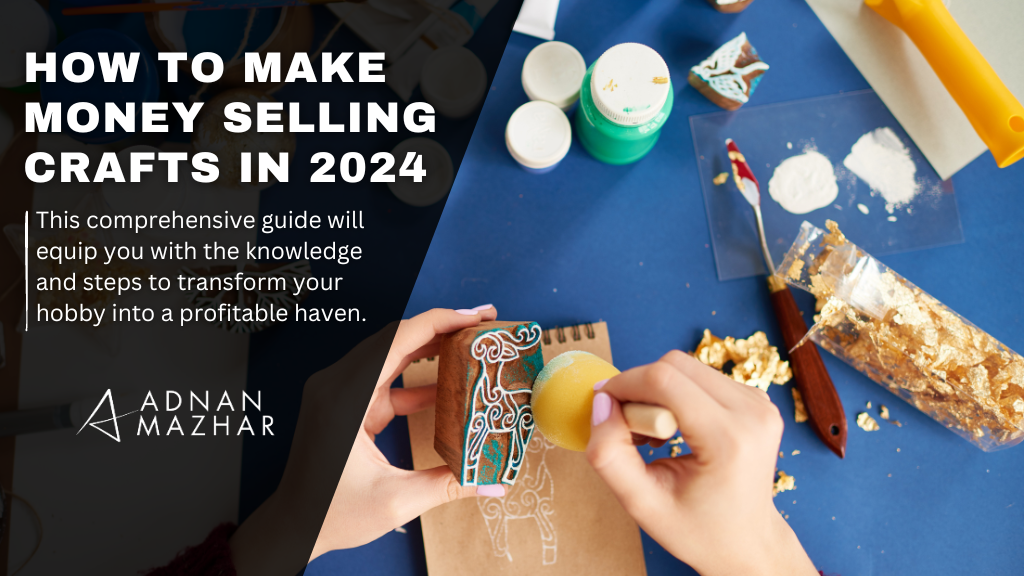
Ever dreamt of turning your love for crafting into a side hustle, or maybe even a full-blown business? You’re not alone! Starting a creative business on “How to Make Money Selling Crafts” offers an exciting opportunity to turn your passion for crafting into a profitable venture.
In today’s world, where individuality and personalization reign supreme, handmade crafts are more popular than ever. But between the thrill of creating and the reality of raking in the dough, lies a strategic path.
Fear not, fellow craft enthusiast! This comprehensive guide will equip you with the knowledge and steps to transform your hobby into a profitable haven, focusing on the unique value and appeal of starting a handmade business.
Additionally, having an online presence, including setting up your own website for selling crafts, is crucial for reaching a wider audience and maximizing your sales potential.
- How to Make Money Selling Crafts?
- Step 1: Choosing Your Craft Niche
- Step 2: Perfecting Your Craft
- Step 3: Crafting a Winning Product
- Step 4: Building Your Brand Identity
- Step 5: Choosing Your Platform to Sell Crafts Online
- Step 6: Pricing Your Crafts for Profit
- Step 7: Photography and Packaging
- Step 8: Spreading the Word about Your Crafts
- Step 9: The Art of After-Sales Service
- Step 10: Growing Your Craft Business
- Conclusion
- FAQs
How to Make Money Selling Crafts?
This section dives into the actionable steps you’ll need to take, transforming your love for crafting into a successful and profitable business venture.
Step 1: Choosing Your Craft Niche

The world of crafts is a vast and vibrant marketplace. From whimsical knitted toys to sleek wooden sculptures, there’s a niche for every creative soul.
But before diving headfirst into production, it’s crucial to identify your sweet spot.
Channel your inner sleuth
Conduct some market research! Explore online platforms like Etsy or participate in a local craft fair to see what’s trending. The experience of participating in your first craft fair, such as the Alternative Media Expo, can provide valuable insights into what’s popular and what sells. Is there a particular style or technique that resonates with you?
Embrace your strengths
Consider your existing skills and interests. Do you have a knack for working with intricate details like jewelry making? Or perhaps you’re a whiz with a sewing machine and dream of crafting statement bags? Turning your own art into a business can define your niche, blending your passion with profitability.
Find the white space
Look for gaps in the market. Are there specific themes or materials that seem under-represented? Maybe there’s a niche for eco-friendly crafts made from recycled materials.
Remember, your niche is your unique selling proposition.
It’s what sets your creations apart from the crowd and attracts a dedicated customer base.
Step 2: Perfecting Your Craft

Now that you’ve identified your niche, it’s time to hone your skills. Here’s where the magic happens!
Practice makes perfect
Dedication is key. Refine your techniques, experiment with different materials, and don’t be afraid to get messy!
Invest in learning resources
Workshops, online tutorials, and craft books can be a treasure trove of knowledge.
Seek feedback
Share your creations with friends, family, or online communities for constructive criticism.
Step 3: Crafting a Winning Product

Not all crafts are created equal. To turn a profit, you need to ensure your creations are not only beautiful but also functional and desirable. Once you’ve honed your craft and created unique pieces, the next logical step is to start selling, transitioning from a hobbyist to a craft business owner.
Focus on quality
Use high-quality materials that will last. Flimsy crafts won’t win over customers in the long run.
Functionality matters
Consider the purpose of your craft. Are you creating a decorative piece or a practical item for everyday use?
Embrace trends (with a twist)
Keep an eye on popular styles, but don’t be afraid to inject your own unique personality into your creations.
Think outside the box
Experiment with unexpected materials or combine different techniques to create one-of-a-kind pieces.
Step 4: Building Your Brand Identity

Your brand is more than just a fancy logo.
It’s the story behind your creations, the emotions they evoke, and the experience you offer customers.
Develop a captivating brand name and logo
This should reflect your niche and resonate with your target audience.
Craft a compelling brand story
What inspires you to create? What makes your crafts special? Share your story with the world!
Consistency is key
Maintain a consistent visual style across your marketing materials (think photos, packaging, and social media).
Step 5: Choosing Your Platform to Sell Crafts Online

There’s a multitude of marketplaces where you can showcase and sell crafts online, reaching a global audience and potentially making significant income.
Here’s a breakdown of some popular options: Having an online presence to sell online is crucial for consistent sales, with platforms like Etsy, eBay, and Amazon Handmade offering easy setups to showcase work to millions.
Selling online offers a convenient alternative to physical craft fairs, allowing you to tap into a wider range of e-commerce platforms starting with Etsy.
Online Marketplaces
Etsy, Amazon Handmade, and Shopify are great platforms to reach a broad audience.
Social Media
Platforms like Instagram and Facebook allow you to connect directly with potential customers and build a community.
Craft Fairs
Participating in local craft fairs allows you to showcase your work in person and interact with customers directly.
Additionally, collaborating with local businesses such as gift shops, cafes, and art stores during these events can further expand your reach and exposure.
Wholesale
Partnering with local businesses, such as gift shops, cafes, and art stores, can help you expand your reach and generate consistent income by displaying and selling your crafts or teaching workshops.
The best platform (or combination of platforms) for you will depend on your target market, budget, and business goals.
Step 6: Pricing Your Crafts for Profit

Don’t undervalue your hard work! Here’s how to price your crafts strategically to earn money:
Factor in material costs
Calculate the cost of all materials used to create your craft.
Consider your time investment
How long does it take you to make each item? Factor in your hourly rate.
Research competitor pricing
Check out similar crafts on your chosen platform to get a sense of the market value.
Leave room for profit
Once you have your cost calculations, add a desired profit margin to arrive at your final selling price.
Experiment and adjust
As you gain experience and your business grows, you may need to adjust your pricing strategy to optimize profitability.
Step 7: Photography and Packaging

In the world of online sales, first impressions are everything.
High-quality photos and attractive packaging can make or break a sale.
Invest in good lighting and photography
Take clear, well-lit photos that showcase your crafts in their best light. Consider using a plain background to make your creations pop.
Experiment with different angles
Capture close-up shots to highlight details and wider shots to showcase the overall design.
Packaging that pops
Don’t underestimate the power of packaging! Use attractive materials, personalize with your brand logo, and consider adding a handwritten thank you note for a special touch.
Step 8: Spreading the Word about Your Crafts

Now that you’ve got beautiful products and a captivating brand, it’s time to shout it from the rooftops (metaphorically, of course). As a small business owner in the craft industry, understanding and implementing SEO strategies is crucial for your success.
Social media savvy
Utilize social media platforms like Instagram, Facebook, and Pinterest to showcase your work, run targeted ads, and connect with potential customers.
The power of storytelling
Use captivating captions and stories to share the inspiration behind your creations and the personality of your brand.
Collaborate with influencers
Partner with relevant micro-influencers in your niche to reach a wider audience and gain exposure.
Content is king
Create engaging blog posts, tutorials, or video content related to your crafts to establish yourself as an expert and attract organic traffic.
SEO optimization
Optimize your online presence (website listings, social media profiles) with relevant keywords to help potential customers find you through search engines.
Step 9: The Art of After-Sales Service

Exceeding customer expectations goes a long way in building a loyal following.
Here’s how to ensure a positive customer experience:
Prompt communication
Respond to inquiries and messages promptly and professionally.
Exceed shipping expectations
Offer clear shipping information, transparent delivery timelines, and consider providing tracking numbers.
Go the extra mile
Include a handwritten thank you note or a small freebie with each order.
Embrace customer feedback
Encourage customers to leave reviews and actively respond to both positive and negative feedback to show you care and are committed to improvement.
Step 10: Growing Your Craft Business

Congratulations! You’ve successfully transformed your hobby into a money-making venture. But the journey doesn’t end here.
Here are some tips to take your craft business to the next level:
Considering the dedication, time, and energy required, turning your craft business into a full-time job could be a viable next step, allowing you to focus on estimating costs, profitability, and expanding your market reach both in person and online.
Analyze and adapt
Keep track of your sales data and customer feedback to identify what’s working and what needs improvement.
Expand your product line
Gradually introduce new products that complement your existing offerings and cater to customer demand.
Consider offering customization
Allow customers to personalize their purchases, adding a unique touch and increasing perceived value.
Network with other crafters
Collaborate with other artists for joint projects, cross-promotion opportunities, or even participate in group craft shows.
Remember, building a successful craft business takes time, dedication, and a dash of creativity. By following these steps and nurturing your passion, you can transform your love for crafting into a thriving source of income and personal fulfillment.
So, grab your craft supplies, unleash your creativity, and get ready to turn your hobby haven into a cash cow!
Conclusion
The world of crafting is brimming with potential, just waiting for your unique touch. By following this comprehensive guide, you’ve equipped yourself with the knowledge and tools to navigate the exciting path of turning your passion into profit.
Remember, the journey is just as important as the destination. Embrace the learning process, celebrate your creative victories, and don’t be afraid to experiment.
With dedication, strategic planning, and a sprinkle of marketing magic, you can successfully transform your hobby haven into a thriving craft business.
So, what are you waiting for? Unleash your inner artist, embrace the power of “handmade,” and get ready to watch your creations not only delight customers but also inspire you to start your own business, filling your pockets with pride!
FAQs
Q: I’m a complete beginner. Can I still sell crafts?
Absolutely! The beauty of crafting is that there’s always something new to learn. Start with beginner-friendly projects, focus on a niche you’re passionate about, and don’t be afraid to experiment. There are tons of online tutorials and resources available to help you hone your skills.
Q: How much money can I realistically make selling crafts?
Your earning potential depends on several factors, including the time you invest, the materials you use, your pricing strategy, and your chosen selling platform. Some crafters start with a side hustle, generating a few hundred dollars a month, while others build successful businesses with significant incomes.
Q: I’m worried about my crafts being good enough to sell.
Confidence is key! But remember, there’s a market for all kinds of crafts, from perfectly polished pieces to those with a touch of rustic charm. Focus on quality and showcase your unique style. Don’t be afraid to get feedback from friends, family, or online communities to refine your skills.
Q: How do I deal with competition from other crafters?
Competition is healthy! It pushes you to innovate and constantly improve. Focus on what makes your crafts unique, develop a strong brand identity, and provide exceptional customer service to set yourself apart. Collaboration can also be a powerful tool. Consider partnering with other crafters for joint projects or cross-promotion opportunities.
Q: What are some legal considerations for selling crafts?
Depending on your location, there might be regulations regarding permits or licenses for selling homemade goods. It’s always best to check with your local authorities to ensure you’re compliant.
Q: Is it essential to have a website to sell crafts?
While a website can be a powerful tool for showcasing your work and establishing yourself as a brand, it’s not always necessary in the initial stages. Many crafters successfully launch their businesses on online marketplaces like Etsy or social media platforms. However, having your own website can offer significant benefits as your business grows. It allows you to have full control over your brand, build a direct relationship with your customers, and avoid marketplace fees. Additionally, it can serve as a central hub for your online presence, integrating your social media and other sales channels.
Q: I’m not very tech-savvy. Can I still sell crafts online?
The good news is that most online marketplaces and social media platforms are user-friendly and offer tutorials and support resources. There are also plenty of online courses dedicated to helping crafters navigate the digital world of selling their creations.


